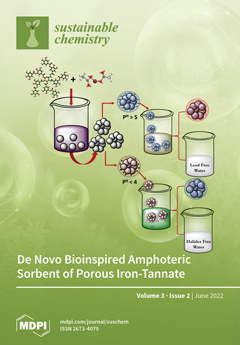Bioinspired porous microstructures of iron-tannate (Fe(III)-TA) coordination polymer framework were synthesized by catenating natural tannic acid with iron(II), using a scalable aqueous synthesis method in ambient conditions. The chemical composition, morphology, physiochemical properties, and colloidal stability of microstructures were elucidated. The surface area
[...] Read more.
Bioinspired porous microstructures of iron-tannate (Fe(III)-TA) coordination polymer framework were synthesized by catenating natural tannic acid with iron(II), using a scalable aqueous synthesis method in ambient conditions. The chemical composition, morphology, physiochemical properties, and colloidal stability of microstructures were elucidated. The surface area (S
BET) and the desorption pore volume were measured to be 70.47 m
2/g and 0. 44 cm
3/g, respectively, and the porous structure was confirmed with an average pore dimension of ~27 nm. Microstructures were thermally stable up to 180 °C, with an initial weight loss of 13.7% at 180 °C. They exhibited high chemical stability with pH-responsive amphoteric properties in aqueous media at pH levels ranging from 2 to 12. Supporting their amphoteric sorption, microstructures exhibited rapid removal of Pb
+2 from water, with 99% removal efficiency, yielding a maximum sorption capacity of 166.66 mg/g. Amphoteric microstructures of bioinspired metal–phenolate coordination polymers remain largely unexplored. Additionally, natural polyphenols have seldomly been used as polytopic linkers to construct both porous and pH-responsive amphoteric coordination polymer frameworks with a robust structure in both acidic and basic media. Thus, this de novo porous microstructure of Fe(III)-TA and its physiochemical surface properties have opened new avenues to design thermally and chemically stable, eco-friendly, low-cost amphoteric sorbents with multifunctionality for adsorption, ion exchange, separation, storage, and sensing of both anions and cations present in heterogeneous media.
Full article





